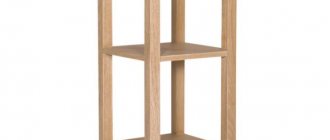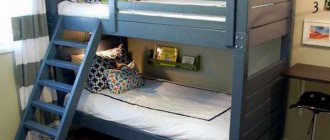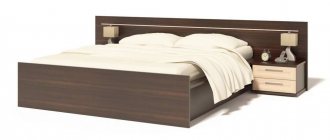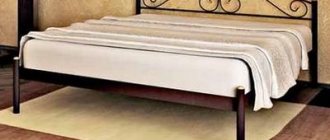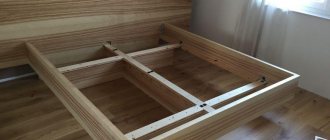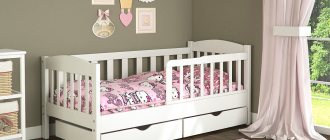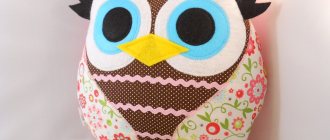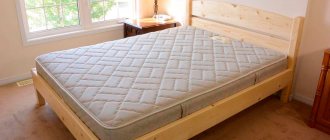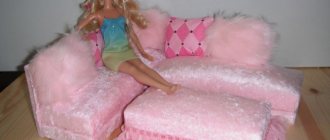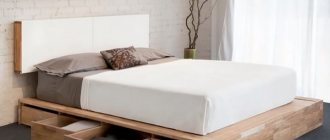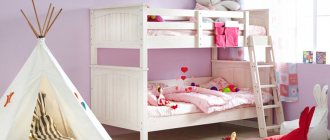Features and advantages of the design
A compact bunk bed made by yourself is a godsend for a small room.
This furniture is placed near the wall or in the middle of the nursery, dividing the room into two zones. The functionality of the product can be expanded if you add a bed, which is located on the upper tier, with a wardrobe or a small desk below. Classic designs consisting of two berths located one above the other are also common.
Children love to play on the second tier, “transforming” it into royal castles, pirate ships, uncharted islands - this is another plus in favor of such furniture. There were also some downsides: at night, it’s not so easy for a sleepy child to get down from the top floor. In addition, the possibility of accidentally falling from the second tier and getting injured cannot be ruled out.
Children under 5 years old are not recommended to sleep on the top bunk of the bed.
It would seem that a huge assortment of various models of bunk beds allows you to quickly and easily make a choice. But ready-made designs do not always take into account the area of a particular room, the age of the children, and the wishes of family members.
The desire to make a children's bunk bed with your own hands is due to obvious advantages. Firstly, such furniture will cost much less than purchased furniture. Secondly, you can come up with your own unique design, supplement the design with the required number of side shelves, drawers or other useful elements.
As an option, you can always use a ready-made furniture project for your work; you can select suitable diagrams and drawings from free thematic resources.
Some types and models of bunk beds
Nowadays, in the assortment of stores you can find many models of beds with two tiers, and on their basis it is quite possible to create your own version of a sleeping place with dimensions and a comfortable staircase suitable for specific conditions and specific location. In addition to traditional bunk structures, you can also make a loft bed, which will free up useful space in the room.
If you consider several different options, it will be easier to choose the most suitable design for your apartment.
Traditional model
This type of bunk bed is traditional and has the simplest design possible. It is quite accessible for self-production and will require a minimum amount of materials.
This model is perfect for a children's room and will significantly save useful space in it, which can be used to arrange a workplace or play area. In addition, the structure can serve as a good platform for intricate children's games, so it should be quite stable, and in some cases it is recommended to firmly fix it to the wall.
The big advantage of this model is the natural wood from which it is made, which is very important for a child’s room. Drawings and a detailed description of the manufacture of this bed model will be discussed below.
Bed option with sofa
A bed that has a folding sofa on its first tier will save even more free space in the room than a conventional two-tier design.
If there is an ordinary bed on the ground floor, it will be uncomfortable to just sit and watch TV, since there is no comfortable backrest. Therefore, in addition to the traditional version of a bunk bed presented above, in a children’s room you will still have to look for a place for a sofa or two armchairs, which, of course, will take up a fairly large area.
Well, if a sofa is built into a two-tier complex, it will serve as a sleeping place at night, and during the daytime it will create a comfortable corner for relaxing while sitting or lying down. In addition, when folded, this piece of furniture will not take up a single extra centimeter of space, and when unfolded, it will become a spacious, full-fledged bed.
To make such a complex yourself, you will have to buy or use an existing sofa and attach the rest of the structure to it, which, by the way, will be stable and reliable due to the massiveness of the lower tier.
Bed model with drawers
This version of a bunk bed, designed for three sleeping places and additionally equipped with drawers and shelves, will take up slightly more space than a regular traditional bed with two tiers.
However, in a children's room you still cannot do without various cabinets and drawers for toys and educational supplies, for which an attached structure can be used, which at the same time serves as a reliable, stable staircase leading to the second tier.
The sleeping places themselves will take up an area that would accommodate one regular bed. As you can see in the illustration, the third berth is a retractable structure, which is hidden under the mattress of the first tier during the day.
Thus, three children will be provided not only with sleeping places, but also with their own drawers and shelves, and in addition - an excellent play complex into which such a two-tier structure can turn.
Model with a double bed on the first tier
A bed with a double bed on the first tier can be used in a one-room apartment, or in a two-room apartment, where it is decided to allocate one of the living spaces as a living room with a workplace. So, the first floor of the bed is reserved for an adult bedroom, and the second is intended for a child.
This version of the trapezoidal design will take up the area of the room, which is usually reserved for an unfolded sofa. To make it, you will need few materials, but due to the widely spaced legs and the large massiveness of the lower tier, the bed will be stable and durable.
Bed for a large family
A bunk structure consisting of four beds is an excellent choice for a family with four or more children. This option is more difficult to make, and it will require a lot of material, but the room will become spacious, and the bed will look neat along one of the walls.
The design can be modified and even increased to six sleeping places if it is installed the length of the room and another two-tier section is added, or two pull-out mattresses are installed under the lower tier.
Loft bed
A loft bed is also used for the purpose of rational use of usable space in the room and a kind of “camouflage” of the sleeping area. This option is suitable not only for small children - it is often chosen for adults, especially if the apartment consists of one room.
This design allows you to use one area of the room for dual purposes - on the second tier there is a wide and comfortable bed, and the lower platform of the first tier is a fairly spacious office, which provides everything for comfortable work.
An important condition for arranging such a structure is its strength, especially if the sleeping place is intended for two people. Typically, such a loft bed is additionally securely fixed to the wall.
Corner designs
Corner bunk beds for children are more functional than classic designs. In some models, the berths are located directly above each other, while in others they are perpendicular.
Bunk beds allow you to fill usually empty space in the corner and hide surface defects. Sleeping places can also be located either above each other or perpendicularly. The staircase to the second tier can be of a classic design or have drawer steps.
Might be interesting Do-it-yourself ottoman at home - step-by-step master classes for beginners
Children's loft bed
The children's version of the loft bed is a whole complex that includes a table and a wardrobe in which not only toys, but also items of clothing can be stored. With some justification, such a complex can even be called a small room, which will become a favorite place for a child, since most children always try to create their own “secret” corner, building huts and houses from chairs and blankets.
By making this version of a bed with all the elements necessary for play and study, you can solve several problems at once and save on buying pieces of furniture for a child for many years, since the complex is suitable for both a five-year-old child and a fifteen-year-old teenager. Moreover, when starting to draw up a drawing, it is quite possible to include already existing cabinets and tables in it, which are perfect for the first tier of the structure.
Upon completion of the work, all elements of the loft bed are united in a common color that will be in harmony with the design of the entire children's room.
Types of designs
Manufacturers offer a wide range of standard bunk beds, models with a work area or with a sofa below. They differ in material of manufacture, configuration, shape, dimensions. To choose the right model for your apartment, you need to understand the features of each type.
Standard
A classic two-level bed with an attached or an extension ladder is the most common and popular model. Designs of this type are easy to manufacture and consist of 2 berths, one of which is located below and the other on the second tier. Such a product is durable, and since it does not have to be folded and reassembled every day, if treated with care, the attribute will last for many years. Classic bunk beds with drawers where the child can put toys or other accessories are very convenient - such models can significantly save space.
Most often, products of this type are installed in a room where two children live with a small age difference. Typically, the older child sleeps on top and the youngest on the bottom. Such a two-level attribute can only be installed in a room where the ceiling height is at least 2.35 m, otherwise sleeping on the second tier will be uncomfortable.
Transformer
Convertible beds are usually made of metal. Due to their versatility and practicality, such models are popular all over the world. It is worth considering that they differ in the method of transformation. The following options are considered the most popular:
- Bed with sofa underneath. Most often, structures of this type are purchased for one-room apartments, where there is no space to place excess furniture. During the day, the lower part of the attribute transforms into a small sofa, and at night into a full-fledged bed.
- Bed with a lifting mechanism in the form of a wardrobe. If necessary, the sleeping place is raised to the wall, after which the attribute looks like an ordinary wardrobe with mirrors and shelves. Such products are very ergonomic and beautiful, suitable for storing various things. Their only drawback is their high cost.
- Folding model. The basis of the product is not a frame, but a body, on two levels of which sleeping places are installed. During the day, folding bunk beds are folded and transformed into a closet with shelves, and at night they are used for sleeping.
- Pull-out bed. Such options are usually installed in children's rooms. Since under the bed there are drawers for storing linen, clothes, toys, this design allows you to significantly save space.
If you decide to purchase a transformable bunk bed, it must be selected in accordance with the individual characteristics of the person. You first need to think about which product will be more appropriate and necessary in a particular case. It is worth considering that most models are intended not only for recreation, but have wider functionality.
Wardrobe bed
Folding
Retractable
Matryoshka
A matryoshka bed is a product that consists of a frame with several pull-out compartments. This attribute is indispensable not only for small apartments, but also for kindergartens, since it allows you to save square meters. If you unfold such a bed, it will take up 2 sleeping places, but if you assemble it, it will take up only one. This frees up space for games and homework.
In most cases, double-decker Matryoshka beds are equipped with low sides that prevent the mattress from moving to the side and also prevent the child from falling during sleep. Another feature of the model is its low height. The child will be able to climb onto the second tier without the use of a chair, ladder or other devices. The side elements often have rounded corners, which reduces the risk of injury to the product. As a rule, models of this type are made of chipboard or MDF. Almost no metal is used for their production.
Attic
Usually it is a bed with a workplace. The relaxation area is often located on the upper tier, and the first is intended for daytime activities. Depending on the age of the child, the lower part can be made in the form of:
- Tables for studying and doing homework.
- Play areas.
- A chest of drawers with drawers and open shelves for storing clothes, textbooks, and sports equipment.
Also popular are bunk beds with a Swedish wall, where the child can play sports. In modern models with a sports complex in the side part, the lower tier is often transformed into an additional sleeping place. It is worth considering that the attic is suitable not only for a child, but also for an adult. If necessary, you can even find triple bunk beds of this type, when there are two sleeping places on the second floor. This product is fixed to the floor using wooden or metal supports.
A separate group includes bunk beds for workers, which are installed in cabins. Such designs are simple and do not have additional elements.
Stair configurations
Another parameter by which bunk beds differ is the staircase. Most often it is made from the same material as the frame. When choosing a product, you need to take into account not only functionality, but also the age of the people for whom the bed is selected:
- Vertical with podium. This product is fixed to the bed and is distinguished by the presence of a raised part in the lower zone. The design is quite stable and suitable even for preschoolers.
- With boxes in the steps. Due to the presence of boxes, the structure is equipped with wide steps, so it will be safe to move along it. Since you can store different things inside the drawers, they can save space.
- Inclined. As a rule, such structures are placed on the second floor - they are not considered the safest.
- Attached. When you need to climb to the second floor, such a ladder is moved towards the bed, after which it can be removed. If the lower part of the structure is wide and stable, the product is considered completely safe.
If the design is purchased for children, preference should be given to inclined or staircases with drawers. Such models are considered the most convenient and safe. Another good option for a child is chest of drawers for bunk beds, which can be used not only for their intended purpose, but also for storing things.
Vertical
With drawers in the steps
Inclined
Pristavnaya
Step by step making a bed at home
Let's take a closer look at assembling a simple single-tier wooden bed for a child at home. For this you will need boards, timber, slats, screws and bolts.
Assembling the frame and base
Assembling the frame is the easiest step. To do this, you need to cut out the side edges in accordance with the drawing, connect them together with self-tapping screws so that a rectangular box with right corners is formed. You can check the evenness of the corners using a triangle.
If the baby has a large build, the parameters of the blanks can be changed upward.
The base is made using slats, which are connected to each other at a distance of five centimeters, and attached to the frame. After this, the sides are cut out, if provided. They need to be attached to the frame and base using self-tapping screws.
When the frame and base are ready, you need to cover everything with varnish or paint. You can also use covering material - fabric, leather or something else.
The back and front sides are filled with strips and fixed with glue.
Making a headboard
This process is a little more complicated. You need to cut a headboard from a sheet of wood or chipboard in accordance with the sketch and sand it. Attach it to the frame and mark its correct position with a pencil. If necessary, saw off the excess, you can give it a more fancy shape.
The parts must fit into each other tightly, without any backlash.
Decorating the back must be done before it is attached to the entire frame. In order to attach it to the structure, you need to drill four holes and connect it with bolts.
Bed assembly
The final stage is the preparation of the last parts and assembly. Cut four legs from a piece of timber and sand them. Attach to the frame.
If you wish, you can make storage boxes at home. To do this, you need to mount boxes with a bottom and attach them to the side walls of the bed using treadmills. In this case, you don’t need to make the legs, you just need to make the footboard and headboard a little longer so that they touch the floor.
Since the furniture is intended for a baby, all impregnations must be natural, not containing toxic or aggressive substances.
Assembling the bed includes connecting all the component elements using bolts and self-tapping screws. Make sure that each element is sanded thoroughly.
Children's hospital
You will need the following materials:
- vertical posts (38 mm);
- frame boards (38 mm);
- boards for slats, planks, railings, steps (20–30 mm thick).
The instructions for assembling a children's bunk crib are quite simple:
- according to the drawing, prepare all the details;
- assemble the ends of the bed from posts and supports;
- attach the side supporting frames to the support;
- fix the cross slats for laying the mattress;
- Attach the protective guard to the headboards at the top;
- assemble a ladder for a bunk bed according to the drawing with your own hands;
- varnish the finished structure.
A crib located on the second floor must have a special fall protection system. The stairs are also subject to increased safety requirements.
Natural environmental friendliness - wood
A do-it-yourself bunk bed made of wood is the most popular option. Wood for manufacturing must be previously prepared, cleaned, and dried.
To protect against fungus, mold, and termites, the material is treated with an antiseptic, special impregnations, and drying oil. This is a very pliable, durable material. Products made from it look elegant and well-made.
Among the positive aspects of use are environmental friendliness, a pleasant, light aroma, simplicity and ease of processing, availability in any price category, a large selection of lumber according to texture, degree of processing, and size.
The disadvantages are the deformation of the finished product when the material is raw, flammability, and massive construction.
Roll-out from laminated chipboard
To make such a model you will need the following materials:
- laminated chipboard sheet (19 mm) - for the main parts;
- furniture board (22 mm) - for the bottom;
- accessories, fasteners.
The assembly diagram includes the following steps:
- the sheet is cut into separate parts according to the drawing;
- assemble the structure using corners and fasteners;
- The lower tier is equipped with wheels so that the sleeping place can move freely.
A roll-out bed is an ideal option for a small apartment.
Decorating the product
A bunk children's bed should not only be absolutely safe for small users, but also beautiful, because the aesthetic aspect is one of the important criteria for children. The color is selected to match the shade of the walls and the tone of the furniture, taking into account the overall style of the interior.
For girls, a children's corner is made in light brown, pink, and white colors. The walls and backs are painted with patterns or ornaments are cut out on them. On the bottom floor of the bed you can make a real house, for example, by hanging curtains and making a window in the side backrest.
The structure is decorated with forged parts, mosaics, or ornaments are applied to the surface using the decoupage technique. For girls, bunk bed models with drawers are suitable: they are convenient for storing clothes, linen, toys or books, while at the same time they act as a laconic, stylish decoration of the structure.
For boys, beds are made in the shape of a ship or car. All shades of blue, green, brown, gray are suitable. Yellow, orange, neon elements would be appropriate. From the second tier you can go down not only the stairs, but also the rope or the slide.
Teenagers are often keen on sports, so designs with a sports wall are suitable for high school students. Often vertical surfaces are decorated with posters and placards - this is the most practical and cheapest option, allowing you to change the decor every day without damaging the furniture.
The model for adults has a more strict design, and a crib for babies can be made in the spirit of your favorite animated film, painting the surface with images of fairy-tale characters.
What are the benefits of handmade furniture?
A homemade bed is always better than a store-bought one. And there are many reasons for this. First of all, the quality of the material used in the work. When choosing it, any master will take into account parameters such as reliability and durability. Therefore, upon completion of the work, he will have confidence that his product will last long enough and will not disappoint with its durability upon first use. It happens that it is impossible to find the right thing in a store. For furniture, this situation is especially relevant: the size of the item may not be suitable, you may not like the design or the types of frame and finishing materials used. The question arises about what is better: ordering an individual production of an item or taking on the work yourself. Sometimes choosing the second option is preferable, because in this case there is no need to find a good master, explain your ideas to him and pay a considerable amount for the work. But the main advantage of any thing made with your own hands, of course, is the special feeling both during work and in the process of using the product - it’s always nice to feel like a creator.
Let's summarize. By creating home furniture with your own hands, you can win on several points:
- price;
- quality characteristics of the materials used;
- unique design;
- individual product parameters.
Pros and cons of bunk beds for children
It is advisable to consider the advantages and disadvantages of bunk beds depending on the specific model. But different types of construction also have common advantages:
- Saving. In this case, we are talking not just about saving space, but also about relatively low acquisition or manufacturing costs. If you buy several beds per room or separate pieces of furniture, the cost will be higher.
- Versatility. A bunk bed is suitable for children of any age and gender.
- Ergonomics. The design with two tiers helps to properly organize the space even in a small room. Moreover, some models can replace an entire furniture set for a child’s room.
It is worth considering the disadvantages separately:
- increased risk of injury. Some children use bunk beds for play, which often poses a risk of falling from a height.
- massiveness. On the one hand, the design with two levels helps to save space in the room, on the other hand, it is very difficult to move, assemble and disassemble it yourself.
What additional requirements should be placed on the upper berth?
There are special safety requirements for the upper tier of a crib.
Attention should be paid to the interfloor stairs and the protective elements of the upper floor.
A bunk bed with sides 30 cm high from the surface of the mattress is a good choice.
The staircase between floors should be comfortable and reliable, made of non-slip materials, and well secured. You should not choose crib models with a strictly vertical ladder; flat elements are much safer. It is better if the staircase is fenced with railings and wide steps. The standard width of the stairs is 40 cm, the optimal distance between the rungs is from 20 to 25 cm.
Sources
- https://mebel-sovet.ru/krovati/dvuhyarusnye/902-svoimi-rukami
- https://stroyday.ru/remont-kvartiry/interernye-resheniya/kak-sdelat-dvuxyarusnuyu-krovat-svoimi-rukami.html
- https://HouseChief.ru/dvuhyarusnaya-krovat-vidy-razmery-materialy.html
- https://mebel-sovet.ru/krovati/dvuhyarusnye/898-dvukhyarusnaya-krovat
- https://krovati-i-divany.ru/dvukhetazhnaya/10-dvukhyarusnaya-krovat-svoimi-rukami.html
- https://babyplayroom.ru/mebel/dvuhyarusnaya-krovatka-svoimi-rukami.html
- https://poztelio.com/krovati/296-dvuhyarusnye-dlya-detei.html
- https://links-stroy.ru/dvuhyarusnaya-krovat-dlya-detej/
[collapse]
Preparation of working tools
A home craftsman will probably have everything you need; you can easily do without professional specialized equipment.
If you don’t have the necessary tool and you don’t know how to use it, you might want to give up the idea of making a bed yourself
You can order parts to be cut according to your drawings in a workshop with professional machines. Then all you have to do is assemble it using a screwdriver, mallet and glue.
To do everything yourself, depending on the chosen material and model, you may need:
- Jigsaw, grinder, saw - hacksaw for preparing parts.
- Drill, screwdriver, preferably cordless.
- Clamps for fixing glued elements or convenient assembly using screws and bolts.
- Planer, sander, emery, router to round the edges of boards, remove fibers, sand finished furniture before painting
- Hammer, chisel, mallet - in addition to driving nails, you will need it when working with dowels.
- Tape measure, pencil, level for marking.
- Brush and roller for varnish or paint.
- Iron - for gluing the ends of MDF or laminated chipboard.
We have specifically indicated the purpose of each tool so that you can choose a replacement for what is missing. For example, without a router it is quite possible to get by with a hand tool, a plane.
